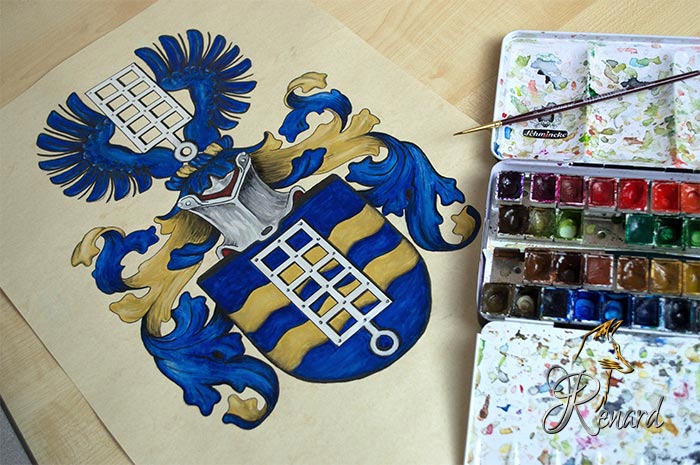Modernization & Ornamentation

There are several ways to represent a coat of arms. The classical types of representation include e.g. paintings on canvases, lithographs but also sculptures or woodcuts. More modern display options would be letterheads or digital versions of the coat of arms, but the stock of the family often contains older graphics. This can be for example heirlooms, which were created many years ago by already deceased artists. The quality of these crests is often not very good due to age. Colors may fade – paper may turn yellow. Such paintings do not necessarily have a value as an antique, so it would be useful to restore them.

We often see coats of arms displayed quite amateurish. Distorted proportions (such as oversized helmets or primitive mantlings) or very simple two-dimensional graphics are characteristic of this. After all, an old painting does not necessarily have to be painted by a talented artist.
There are many cases in which we can help out to create a new work of art and to put an existing coat of arms in scene.

Colored coats of arms from monochrome templates
We are happy to put the desired painting of the coat of arms from a monochrome template.
A coat of arms may well have been handed down in a monochrome representation. This is often seen in lithographs. To be able to rewrite the individual colors of the picture nevertheless, the artists use a code, which consists of hatching and puncturing (= tinging or tincture of a coat of arms). A more detailed explanation can be found on the following page: Tincture.

Monochrome representations without a “color pattern” require a description in order to be reproduced as a colored painting. This coat of arms description is also called blazon.
Coat of arms based on a blazon
If under certain circumstances only a graphic of the sign or even only the blazon exists, we like to complete the coat of arms with the desired additional elements. In advance to editing, we can discuss the composition using collages on the PC. So the customer has the opportunity to be involved in the design process. The project process is similar to that of designing coat of arms [LINK] or the working-out of a new (family) coat of arms.

Painting based on a digital graphic
Vector graphics or computer animated images are great as a template for a hand-painted painting. Newly designed coats of arms are often only available in this form, since the layout is nowadays preferably created on the PC. Often the designers are not classical painters and therefore do not offer hand-painted coats of arms.
For the most part, digital graphics can be brought to paper. The proportions are correct in most cases. A perspective distortion (as often seen in photographed paintings) does not exist. Minor fixes are made during the painting process. So a digital graphic is often two-dimensional. Inner and outer shades are missing as well as lighting effects.
Perspective distortion
The main problem with photographed coats of arms (of any form of representation) is the perspective distortion. Minimal inclinations of the camera can strongly distort the perspective. The coat of arms appears wider or narrower than it can be seen in the original.
Below is a comparison that illustrates the problem.
We automatically correct such distortions on the document or document paper, whereby, the painting will logically vary in terms of proportions.

